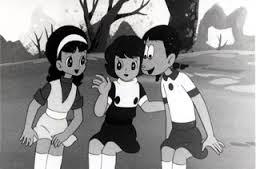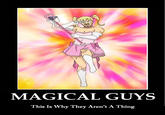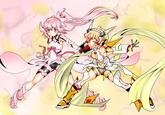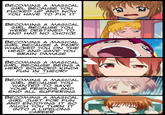Magical Girl
Part of a series on Anime / Manga. [View Related Entries]
[View Related Sub-entries]
This submission is currently being researched & evaluated!
You can help confirm this entry by contributing facts, media, and other evidence of notability and mutation.

About
Magical Girls (or Mahou Shoujo) are a sub-genre in anime and manga identified through its use of female protagonists who are able to transform into magical beings and use magic. Although already a popular genre within anime, it earned renewed popularity starting in 2011 following the Tv airing of Puella Magi Madoka Magica.
History
While the idea of transforming into a different being through magic goes back as far as the Middle Ages through the concept of shapeshifting,[2] Himitsu no Akko-chan[1] (shown below, left) is typically accepted as the earliest magical girl manga. The manga was first published in the shojo manga magazine Ribon in 1962. The anime adaptation of Himitsu no Akko-chan however wouldn't air until 1969, by when Sally the Witch[6] (shown below, right) had already started airing in 1966, which is therefore regarded as the first magical girl anime.


In 1973, the manga for Cutie Honey was released, with was followed shortly after by an anime adaptation. Author Go Nagai claimed that Honey Kisaragi was the first female protagonist of a shonen manga series. In reality, Cutie Honey was the launch pad for the magical girl genre, featuring beautiful transformation and action sequences along with a large amount of fanservice, which made the series appeal to male viewers as well as female viewers. Honey becoming completely nude during her transformations was seen as a skeptical choice, but it would become a prominent feature of many magical girl series to come. Cutie Honey attained tremendous success and would return with more anime series in the future, most recently Cutie Honey Universe, which premiered in 2018.


Reception
In 1992 the manga for Sailor Moon[3] was released, which was followed by an anime adaption a year later. Sailor Moon popularized the concept of a team of magical girls instead of a single heroine and redefined the genre by making the magical girls use their powers to fight evil. The anime was credited by some for revitalizing the magical girl genre itself and the manga also received the Kodansha Manga Award in 1993.[7] Although the anime originally only planned to air for six months, the popularity of the anime caused it to be repeatedly continued to eventually conclude after a five-year run. Due to its success, many magical girl series after Sailor Moon incorporated similar concepts.


From May 1996 to June 2000 the manga for Cardcaptor Sakura[8] was serialized and released, inbetween also having an anime adaptation air alongside the manga from April 1998 to March 2000. The Cardcaptor Sakura manga was praised its creativity, whereas the anime adaptation also received praise for its above-average artwork for the time. The TV anime won the Animage Grand Prix award for Best Anime in 1999[9] and the manga series was awarded the Seiun Award for Best Manga in 2001.[10] Cardcaptor Sakura also popularized the idea of cards into the magical girl genre, which are magic cards used as disposable mana to allow the user to use its powers and transform alongside it, a feature Cardcaptor Sakura was also praised for due to the variety in transformation sequences it created with each card. Both the anime and manga returned to the spotlight with a sequel titled Cardcaptor Sakura: Clear Card,


In 2004, two new magical girl anime franchises began that would change the course of magical girl anime forever. Pretty Cure and Magical Girl Lyrical Nanoha aired their first seasons, and both earned praise from fans and critics alike for being more combat-oriented anime that could also appeal to a male demographic. Pretty Cure was compared to a mix between Sailor Moon and Dragon Ball for its flashy martial arts fights, while Lyrical Nanoha was similarly compared to a mix between Sailor Moon and Gundam for its intense beam weaponry battles. Although neither series attained the worldwide popularity of Sailor Moon due to a lack of western releases, their impact on the magical girl genre is unmistakable and is still felt to this day.


In January 2011 the anime Puella Magi Madoka Magica[5] started airing with a total of 12 episodes. Despite the low amount of episodes, the series managed to give the magical girl genre renewed popularity due to its mature themes, darker atmosphere, and brilliantly-animated battles. This series took the combat-oriented style that Pretty Cure and Lyrical Nanoha introduced and mixed it with a very dark story based on psychological horror, creating a unique and unforgettable experience for viewers. The BD volumes each managed to break sales records, and the anime had grossed a total of 40 billion yen in the sales of related goods by July 2012.[11] The anime also received various awards, including the Television Award at the 16th Animation Kobe Awards[13] and the Grand Prize for animation in the 2011 Japan Media Arts awards.[12]


Impact
[Researching]
Cosplay

Magical girls are popular subjects for cosplay because of their decorative nature. Often times it is not even required to cosplay an official magical girl because of easily recognizable "magical" traits such as colorful hair, ornamental outfits, and handheld items.
Fandom
[Researching]
Related Memes
Transformation Sequences
Because of the popularity of transformation sequences, many fans of the genre like to create their own transformations with both known characters and their own creations.
The length of the transformation sequences led to fans question how it would look from a viewer's perspective, creating a trope used that focusses on the subject of parodies and fourth-wall jokes.

Search Interest
External References
[1] Wikipedia – Himitsu no Akko-chan
[2] Wikipedia – Shapeshifting
[3] Wikipedia – Sailor Moon
[4] Television Tropes & Idioms – Magical Girl
[5] Wikipedia – Puella Magi Madoka Magica
[6] Wikipedia – Sally the Witch
[7] Waybackmachine – Kodansha Manga Award
[8] Wikipedia – Cardcaptor Sakura
[9] Animage.jp – Animage Grand Prix Award
[10] Waybackmachine – Seiun Award
[11] AnimeNewsNetwork – Madoka Magica Anime Earns Over 40 Billion Yen in Goods
[12] AnimeNewsNetwork – Madoka Magica Wins Media Arts Awards
[13] AnimeNewsNetwork – Madoka Magica Wins Anime Kobe Awards












![Madoka - Ante Up [REUPLOAD] Madoka - Ante Up [REUPLOAD]](https://i.ytimg.com/vi/MPwF6YTLLuc/hqdefault.jpg)





